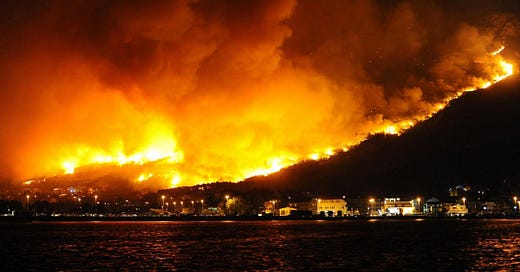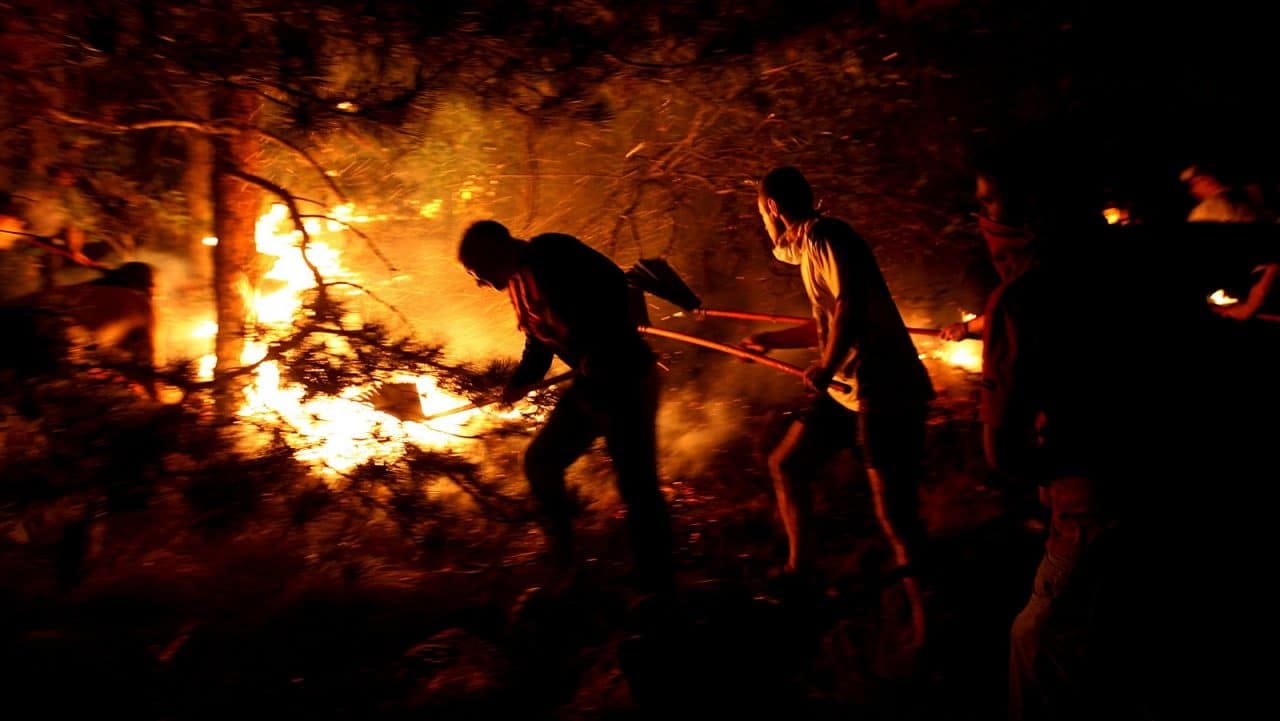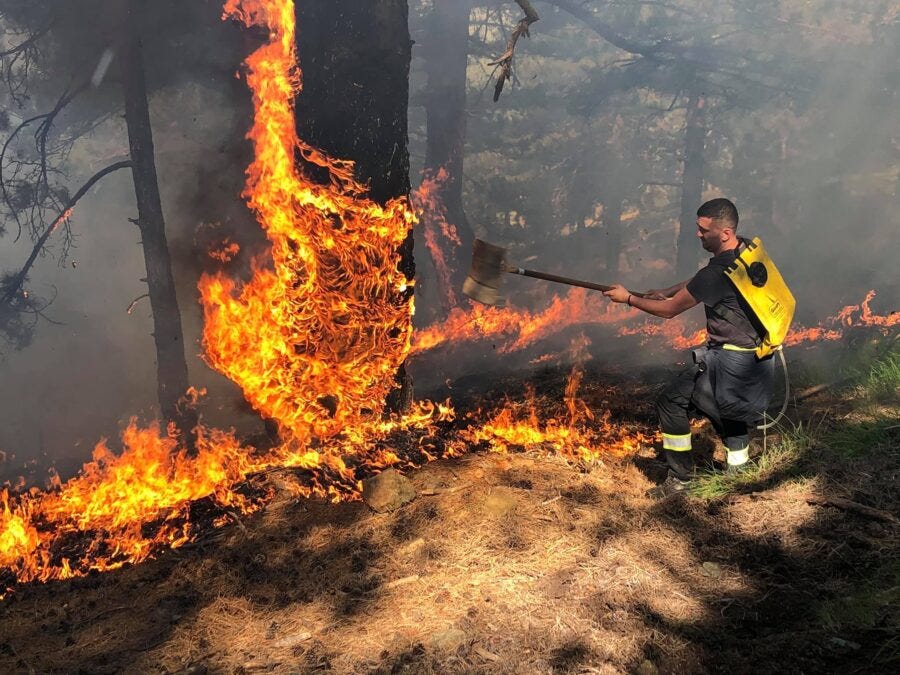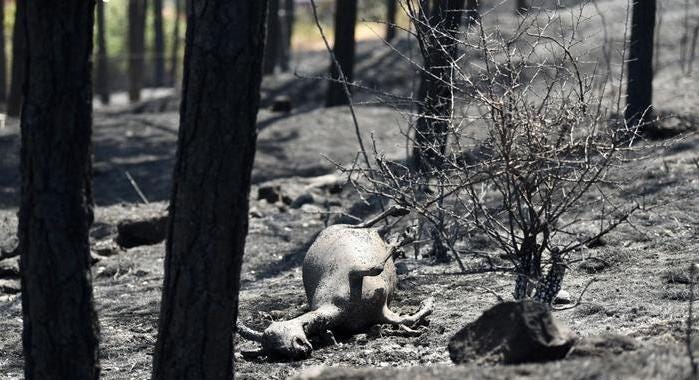S2E3. The summer that burned the Balkans
South-eastern Europe is being devastated by a series of wildfires during one of the most intense heatwaves of its history. The responsible are climate change and human decisions
Hi,
welcome back to BarBalkans, the newsletter with blurred boundaries.
This has been the hottest summer of Europe history. In the village of Floridia, just outside Syracuse (Italy) 48.8 degrees Celsius were recorded on August 11.
The same happened in the Western Balkans: temperatures reached almost 45 degrees.
We have opened the first chapter of a book with a very precise title.
Climate change.
What we are reading is not reassuring.
Extreme weather phenomena, droughts and fires on a regional scale are the most evident natural events during the dry season.
And if we do not start cutting greenhouse gas emission, the next chapters will be increasingly more devastating.
Summer 2021 will be remembered as the one when the Mediterranean coasts turned fiery red and were ash-covered. From Italy to Turkey, from North Africa to Greece.
The summer that burned the Balkans.
One month in hell
If we can still use the expression “it all started with” in the era of climate change, it all started with the wildfire in Croatia on July 10, off the coast of Split, on the island of Čiovo.
It spread over the following weeks in the Dalmatian region. At the beginning of August the huge fire in Trogir destroyed 400 hectares of Mediterranean scrub.
At the same time, Bosnia and Herzegovina and Montenegro were burning.
The exceptional heat wave that invested the peninsula in the first two weeks of August made the forests a perfect fuel.
On August 8, a climate crisis haunted western Bosnia, near the town of Tomislavgrad. By mid-August, the area around the city of Mostar, some fifty kilometers further south, was in the same situation.
On the same days, other large-scale wildfires broke out in the Adriatic hinterland of Montenegro, around the city of Nikšić and, further south, outside the capital Podgorica.
South is the key word.
The lower the latitude, the worse the situation was.
Since July 20, almost the entire Albanian territory has been engulfed in fires and hundreds of hectares of forests, pastures and olive groves burnt.
The scenario on the Prokletije mountain range, also known as the Albanian Alps or Accursed Mountains, is spectral.
For days, the forests along the border between northern Albania and western Kosovo were swept away by flames. One person died trying to save livestock.
Radio Free Europe’s drone images recorded on August 6 near the village of Shtupeq i Vogël (Kosovo) witness the devastated landscape left behind by the fires:
But it is North Macedonia that has suffered the most.
During a 43-degrees heat wave, some 120 wildfires broke out from July 26 to August 19.
Since August 3, the government in Skopje has imposed the complete ban on movement in the country’s woodland areas, asking citizens to stay away from the forests for personal safety and to prevent further fires.
Houses, private properties and thousands of acres of pine, beech and oak forests were destroyed.
North Macedonia declared the state of emergency on August 5 for the following 30 days.
The International Federation of Red Cross Societies initiated an emergency programme with almost half a billion dollars in funding.
Serbia sent four Canadair on a mission, responding to the Macedonian call for help.
The European Union activated the European Civil Protection Mechanism in North Macedonia and Albania, in order to coordinate the fire brigades from several member States, including Slovenia.
However, the cost of this summer wildfires will be felt for decades to come.
Every forest burnt will have a negative effect on the local climate, every pasture destroyed will threaten farmers’ livelihoods.
And the hills - which are now completely bare - hide a new danger: landslides and flash floods.
Human will and climate change
The hot summer in south-eastern Europe was observed by the “eyes” of Copernicus, the European Union’s Earth Observation Programme.
Vast amounts of global data from satellites provide information on natural phenomena and the environment to users and public authorities.
For instance, on the European Forest Fire Information System (EFFIS), which supports the services in charge of the protection of forests against fires in the EU and neighbor countries.
This was the situation from July 10 to August 27:
The extreme heatwave is an immediate cause of the outbreak of the impressive number of wildfires.
But at the same time this is the effect of a larger phenomenon.
Climate change.
The Study on climate change in the Western Balkans region, commissioned in 2018 by the Regional Cooperation Council and funded by the EU, stated:
«Under the great impact of global warming, the observed temperature increase of 1.2° C is expected to further increase by 1.7° to 4°C, depending on the global effort in reducing greenhouse gas emissions».
The impact of climate change is shown by clear signs across the region: «Increased frequency and duration of heatwaves, drought and flood risk, and forest degradation related to increased fire spreading».
Climate change «shows the intrusion of sub-tropical climate further to the north, leaving coastal and southern areas very hot and dry during summer season».
Not only «summer season is expected to last longer by one or two months by the end of the century», but extreme events «will tend to intensify in the near future».
This is all part of the framework drawn by Climate Change 2021: The Physical Science Basis, the first part of the IPCC Sixth Assessment Report (the UN Intergovernmental Panel on Climate Change).
Coincidentally, the report was published as fires ravaged the Balkans on August 6.
Without immediate, rapid and large-scale reductions in greenhouse gas emissions, the goal of limiting global warming to 1.5° or even 2°C will be completely out of reach.
Human activities are responsible for global warming and climate change.
Should it not be clear enough that humans’ hand is behind the extreme phenomena that have burnt the Mediterranean coasts and hinterland, we can find clearer evidence.
First of all, the irresponsible or criminal attitude. It is estimated that 80% of wildfires are caused by human actions.
After two weeks of flames, on August 10, the Albanian police arrested 15 people for arson, which destroyed hundreds of hectares of forests in the country.
In Kosovo, 20 people have been arrested. The police reported «109 cases of arson, 71 cases of general danger and 95 fire incidents, endangering citizens’ lives».
In North Macedonia, 14 people confessed to having caused some of the largest wildfires in the country. Near the capital Skopje, an elderly man was arrested for lighting stubble, which caused a small fire.
We have to consider this fact.
At a time of climate change, lighting stubble in a dry forest area is an unjustifiable act.
But the fact that an elderly person was the responsible one may argue that there was no malice in his actions.
On the contrary, it may be the expression - although unconscious, considered the current natural conditions - of former common practices. That is to say, competent human activities in the forests, which have been almost totally lost.
These include prescribed fire, whose aim is precisely to prevent large wildfires.
The mechanism is very simple.
Forests that have adapted to human activities over millennia are becoming more uniform: gaps are being filled up with dry stuff and layers of vegetation that allow flames to reach the highest crowns of the trees.
Over the centuries, forests have evolved in such a way to require human care. Prescribed fires, practiced for centuries by indigenous peoples from the Balkans to Australia, were used to care and clean woodland.
However, this care practice has been dropped for a number of reasons and made even prescribed fire a dangerous activity.
First, because of a “colonizing” attitude and the intention to make forests look uncontaminated areas - which practically do not exist - to please tourism.
And then, because of questionable - if not completely unethical - forest fire prevention activities carried out in recent decades.
The example of the most haunted Balkan country is enough.
In 2020, a research by the NGO Center for Civil Communications revealed that North Macedonia’s fire-fighting units are severely underfunded, with insufficient personnel and an average vehicle age of 28 years.
Fire trucks manufactured in 1966 are still operational. On the other hand, the three State-owned Canadair cannot be used because they have not been maintained for two years and are not airworthy.
What has been observed in 2021 is just a preview of a summer drama that will tend to get worse year after year.
We know for sure. We must act now.
Pit stop. Sittin’ at the BarBalkans
We have reached the end of this piece of road.
You may be surprised - or maybe not - to discover that today on our bar, the BarBalkans, there is... a glass of water.
And not just for mental association with fire.
But also to remind us of another imminent threat.
Climate models for the Western Balkans predict not only a rise in average temperatures, but also a decline in the availability of drinking water of 10 to 13% by 2060.
In the worst-case scenario, some river basins will lose a quarter of their water by the end of the century.
Meanwhile, humankind is proving to be incapable of managing natural resources.
Pipeline holes, loose connections and defects not timely discovered cause a waste of 250 million cubic meters of drinking water every year in the eight Balkan capitals.
That is like filling 100 thousand Olympic-size pools. Combined in length, they would stretch from Ljubljana to Kabul (thinking of the crisis in Afghanistan).
Every year.
An almost unimaginable quantity of water. Zagreb holds the record, with almost 64 million cubic metres lost (25,582 pools).
But in the perspective of a future with less and less drinking water, it is important to emphasize the percentage of wastage.
No one is worse than Sarajevo, with 6 liters lost every 10 flowing in the pipes. Right behind, Zagreb (52%), Podgorica (49%) and Pristina (48%).
About a quarter of water in Ljubljana (28%), Belgrade (25%) and Skopje (22%) is wasted. Tirana manages to save 9 out of 10 liters.
When temperatures exceed 40°C in summer, the supply of drinking water is already strained in some Balkan cities. And the problem can only get worse in the future.
This is another area that needs immediate action.
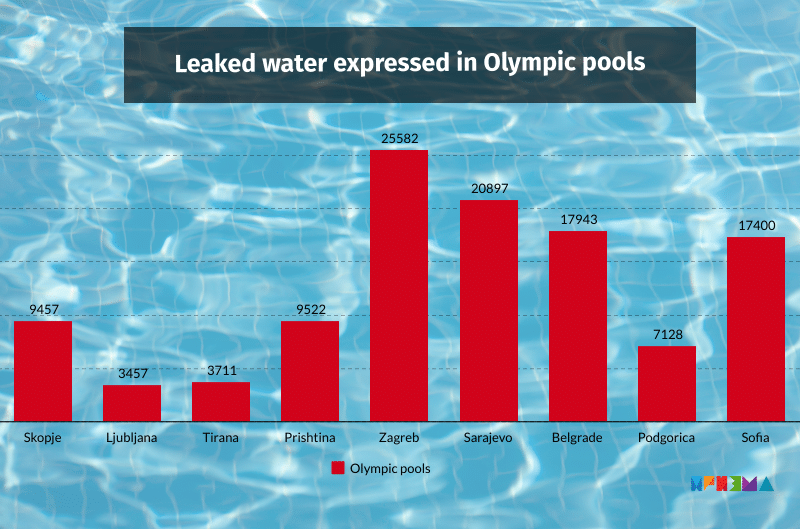
Let’s continue the BarBalkans journey. We will meet again in a week, for the 4th stop.
A big hug and have a good journey!
BarBalkans is a free weekly newsletter. Behind these contents there is a lot of work undertaken.
If you want to help this project to improve, I kindly ask you to consider the possibility of donating. As a gift, every second Wednesday of the monthyou will receive a podcast with an article about the dissolution of Yugoslavia.
Every month you can listen to the preview of BarBalkans - Podcast on Spreaker and Spotify.
Pay attention! The first time you will receive the newsletter, it may go to spam, or to “Promotions Tab”, if you use Gmail. Just move it to “Inbox” and, on the top of the e-mail, flag the specific option to receive the next ones there.
As always, I thank you for getting this far with me. Here you can find all the previous newsletters.
BarBalkans is on Facebook, Twitter and Instagram. The updated archive is on Linktree.

